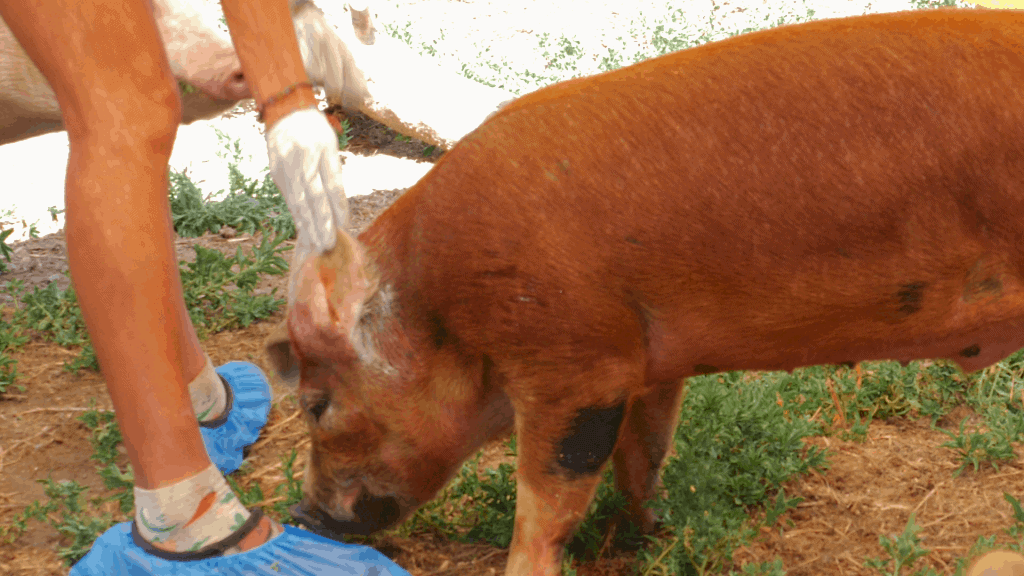
Taking in residents at an animal sanctuary means committing to a high quality of care for their whole lives, protecting them from injury and disease wherever possible. If you take in pigs, this includes providing regular sun protection for each of them, especially in the sunnier and warmer seasons. As much as pigs enjoy sunbathing, as in humans, there’s such a thing as too much sun! And much like in humans, failing to provide effective sun protection can easily lead to painful sunburns and skin cancer, which could ultimately cause the premature end of a pig’s life if left unmanaged.
Sun Risks
Pigs who have lighter or white skin and those who have less protection from body hair (especially large breed pigs such as Landrace or Yorkshire) tend to be at a higher risk of developing sunburns more quickly, but all pigs are potentially susceptible if not afforded protection from the sun. For pigs, sunburns manifest as reddened, sometimes splotchy, sometimes scabbed or blistering skin. Sunburns can be highly painful and must be treated to keep the pig comfortable, such as with a pig-safe soothing ointment like aloe vera. Over time, these burns could develop into squamous cell carcinoma, the same common skin cancer that humans can develop from prolonged exposure to UV rays. If you are concerned that a pig may be developing skin cancer, it’s important to have your veterinarian evaluate them as soon as possible! Early intervention is critical for better health outcomes.
Pigs are also susceptible to hereditary skin cancer not caused by excessive UV ray exposure. Malignant melanoma has been reported in pigs (especially darker-colored pigs, in contrast to squamous cell carcinoma), which can be very difficult to treat. If you notice any change in a pig’s skin, take note of it and consult with your veterinarian as soon as possible!
The most common areas for pigs to get sunburns or develop skin cancer are on and behind their ears, though it can also affect their back, shoulders, and their abdomen if they spend too much time lounging on their side in the sunshine unprotected. Pigs are at risk of getting sunburned during the spring, summer, and autumn, although sanctuaries located in areas that receive a lot of sun in the winter months (and therefore have pig residents who like to be outside in the winter) can be equally problematic.
Fortunately, there are a number of different ways that a sanctuary can protect their porcine residents from the sun!
Provide Appropriate Pig Living Spaces
The easiest way to prevent overexposure to the sun is by providing an appropriate pig living space that includes ample shade and a place for pigs to escape the elements if they so choose. Ideally, they should be able to enter and exit their indoor living space at will during the day so they can be as comfortable as possible. The outdoor living space that pigs have access to at your sanctuary should have areas that are shady, either by creating an overhanging roof near their indoor living space, or installing an awning to provide shade. A sanctuary could also hang a UV-blocking fabric shade rather inexpensively to create a shady area for pigs to lounge under. Large trees with ample leaf coverage can also provide shade for pigs, so long as there’s enough shady area for everyone who wants to be covered!
Provide Mud For Pigs
Pigs are naturally drawn to mud as a source of staying cool and protected from the sun. Mud pits are relatively easy to create, though muddy areas must be maintained and regularly cleaned of fecal matter in order to keep pigs healthy. If you are caring for pigs who are less excited about wallowing in mud, you can apply mud to their ears, backs, and shoulders early on in the day to offer them a degree of natural sun protection. Just make sure that they don’t rub it off halfway through a hot afternoon!
Provide Sunscreen For Pigs
In addition to mud, sanctuaries should also apply pig-safe sunscreen to residents’ ears, back, belly, and shoulders when necessary. Although this option might seem time-consuming, regularly applied sunscreen is very effective at preventing sunburns, and should be especially integrated into a care schedule if a resident pig is constantly getting sunburned in specific areas of their body. On sunny days, it is recommended that you apply sunscreen to light and white skinned pigs’ ears and the area behind their ears, as these areas are very sensitive and are more prone to sunburn and skin cancer. When you perform a regular health checkup on resident pigs, take note of any frequently problematic skin areas, and make sure that they’re being regularly protected, especially in the seasons when pigs lounge outdoors. The effort required to apply sunscreen is much more compassionate and less complicated than treatment if a pig gets burned.
SOURCES:








